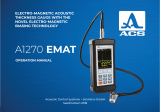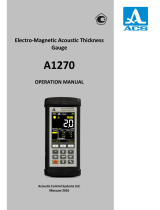Page is loading ...

Ultrasonics
GE Inspection Technologies
GEInspectionTechnologies.com
Calibration ranges
min.: 0 - 2.5 mm; 0 - 0.1” (steel)
max.: 0 - 9700 mm; 0 - 381” (steel)
Sound velocity range
500 - 15000 m/s; 0.02 - 0.59 “/ms
integrated, editable material table
Pulse shift
-10 - 1500 mm; -0.39 - 50” (steel)
Probe delay
0 - 100 µs
Damping
50 ohms / 500 ohms; 1000 ohms with Dual or
Through-Transmission modes
Intensity
220 pF / 1 nF
Frequency range
0.5 - 20 MHz (-3 dB); 4 filter ranges
Pulse repetition frequency
1-1000 Hz, automatically or manually adjustable
Gain
110 dB, adjustable in steps of 0.5 / 1 / 2 / 6 dB
Operating modes
Pulse-Echo, Dual, Through-Transmission
Rectification
full-wave, positive half-wave, negative half-wave, RF
display (up to 150 mm/5.9” steel)
Suppression
0 - 90 % linear
DAC/TCG
DAC with up to 16 curve points (reference reflectors),
dynamic range 37 dB, maximum slope 6 dB/ms;
3 additional curves at adjustable dB distances, can
be changed to TCG (Time-Corrected Gain) mode
(horizontal recording threshold); meets national and
international test specifications
DGS
recording curves for all valid equivalent reflector sizes
and probes with DGS capability; setting as DAC or TCG;
evaluation in dB related to curve, ERS or class (JIS);
sound attenuation and transfer correction; reference
reflectors used: backwall, circular disk reflector and
side-drilled hole
Monitor gates
2 independent monitor gates, adjustable over the entire
maximum calibration range; evaluation on the basis of
A-scan at display refresh rate; gate alarm: off, coinci-
dence, anticoincidence; visual and/or acoustic alarm
Distance measurement
individually selectable for each gate at the echo flank
or peak, in the RF mode addition-ally at the zero
transition of the increasing or decreasing echo flank
- initial pulse and measurement point in
gate A or B
- measuring points: gate B - gate A
(differential measurement)
Measurement resolution
sound path / time of flight: up to 12.6 mm: 0.01 mm;
otherwise 0.2 % of display width
Amplitude
0.5 % screen height or 0.2 dB
A-scan digitization
1024 x 1024 pixels
Display freeze
static A-scan freeze, dynamic A-scan freeze (peak
value, echo dynamics + real-time signal), average
freeze via 2 to 32 ultrasonic pulse cycles
Echo comparison
simultaneous display of the currently active signal and
a stored A-scan
Outputs
documentation via standard interfaces of the notebook
Inputs
2 analog inputs, e.g. for probe coordinates,
digitization with 10 bits each
Dialog languages
German, English, French, Spanish and Italian
Units
mm, inch, µs
Probes
standard and dialog probes (automatic recognition)
can be connected
Data storage
database for storing and managing instrument
settings, test jobs and test results, including A-scan,
DAC and alphanumeric comments, Export to
Microsoft Excel; limited only by the hard disk size
Software
operating system: Windows2000/XP; Client-Server
interface OLE 2.0; options: UltraWORKS (design tool),
FFT (Frequency analyses)
EHT (hardening depth), RTM (resonance thickness
measurement with 1 µs resolution), UltraLOG
(evaluation program for spot weld testing)
Notebook versions (trademarked units)
standard or industrial version (IP 52)
Mains and battery operation
approx. 5 h, depending on the processor workload
Operating temperature
5 °C - 45 °C; 41 °F - 113 °F (standard)
0 °C - 50 °C; 32 °F - 122 °F (industrial)
Dimensions (H x W x D)
63 mm x 300 mm x 230 mm;
2.5” x 12” x 9” (standard)
64 mm x 302 mm x 273 mm;
2.5” x 11.9” x 10.7” (industrial)
Krautkramer USLT 2000
The Ultrasonic Test System
in a Notebook for Today and Tomorrow
Specifications
©2004 General Electric Company. All rights reserved GEIT-20001-s-US (09/04)
We reserve the right to technical modifications without prior notice.
/




